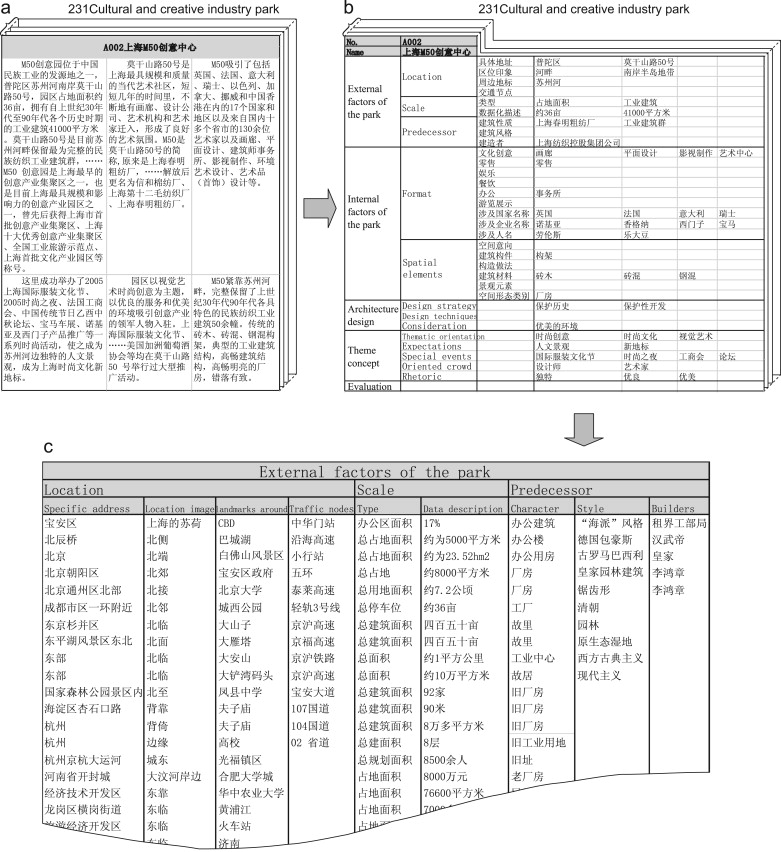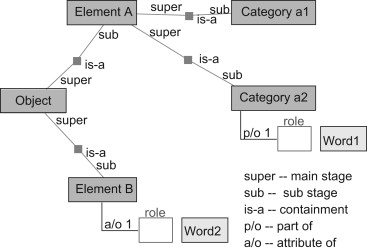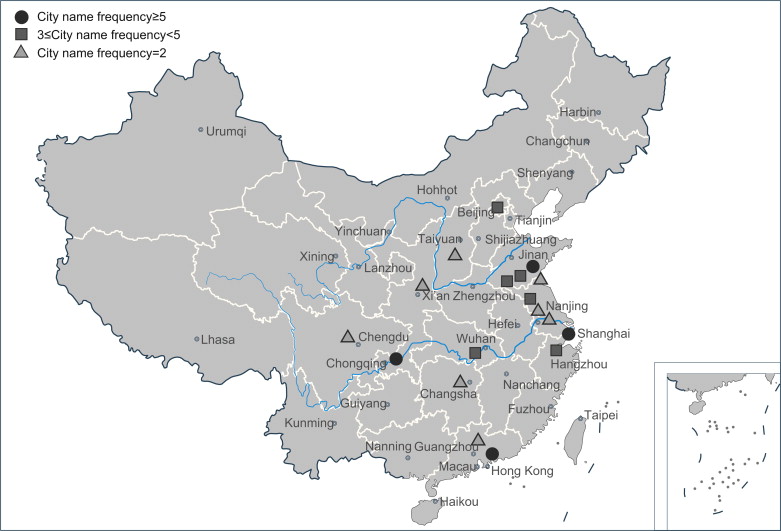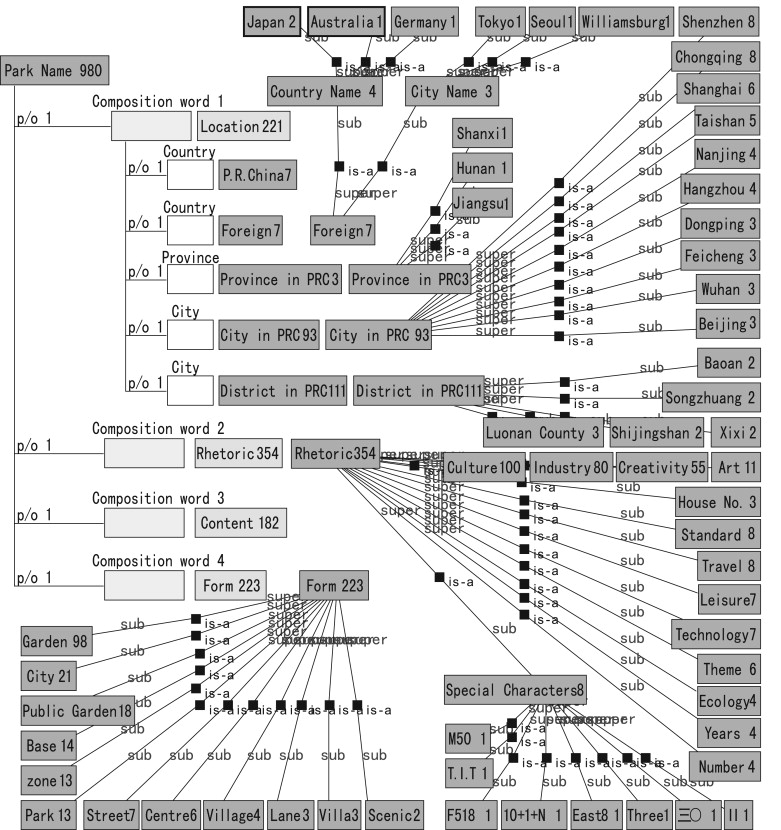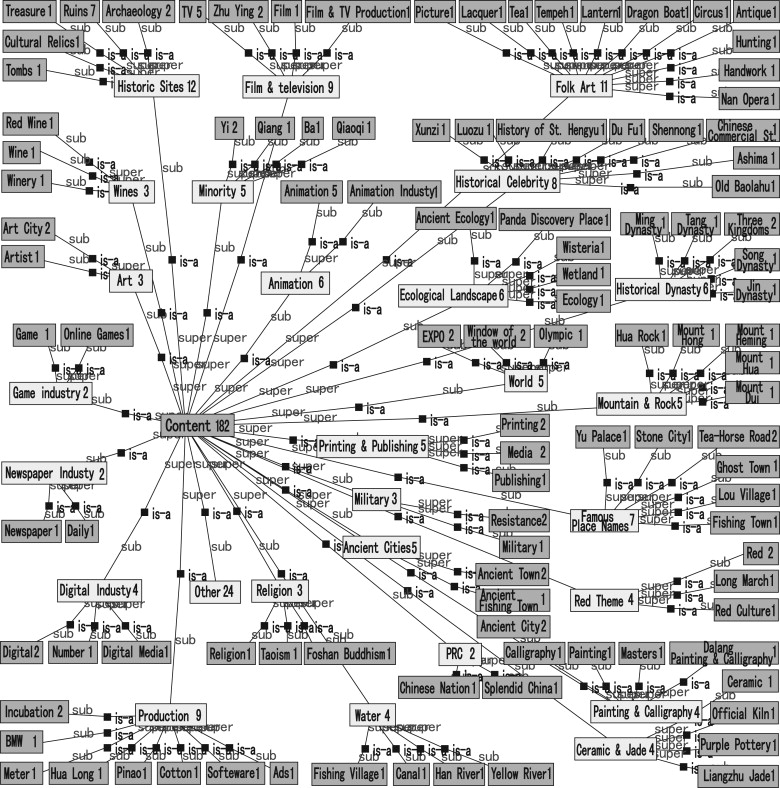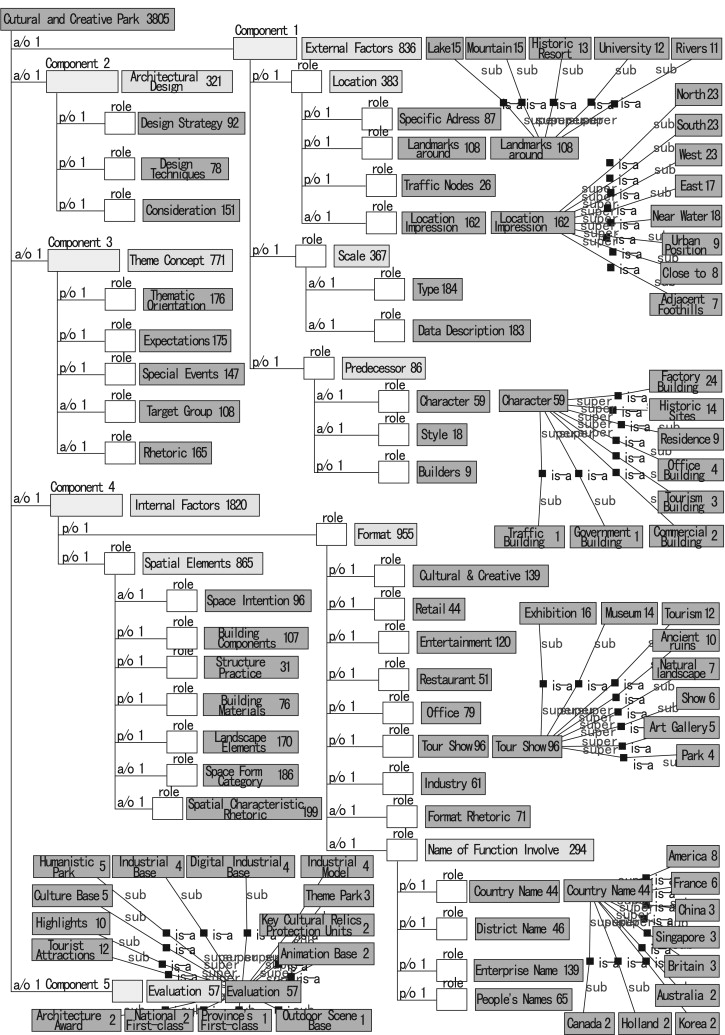Abstract
According to the information of 231 cultural and creative industry parks on the Internet literature, this research classified and studied the park elements from the text using the method of semantic Ontology analysis. The paper analyzes the cultural and creative industry park in the performance of type, constitution elements of geographical attributes, characteristics, etc. Through analysis, we found that “location”, “form” and “rhetoric” are frequently mentioned in the park names. As the parks prefer to combine cultural relics with their own characters for highlighting influence and specialties, the park locations also have certain restrictions (e.g., “historic sites”, “ancient cities”). Furthermore, cultural and creative industry parks cover a wide range of contents (e.g., “digital industry”, “ecological landscape”). The boundaries of the park type and content are not very clear in present China. And, the parks lack of overall planning and often have an imperfect industrial chain and other issues. Therefore, on developing cultural and creative industry parks, the overall planning and perfect industrial chain need to be focused on.
Keywords
Internet literature ; Cultural and creative industry park ; Semantic structure ; Ontology analysis
1. Introduction
1.1. Research background, purpose and methods
The creative industry is a new industry developed in the background of the global consumer society. It has the characteristics of high innovation, high value-added and high industrial interrelatedness. Based on knowledge and creativity, the creative industry has become the leading industry of the developed countries and cities. The late appearance of Chinas cultural and creative industry park, combined with Chinas specific facts, will be defined as multi-functional park, which has a series of cultural relevance and often includes trading, recreation and housing. At present, the internet and other means of communication-oriented cultural and creative industry has become the development trend, and it is increasingly important to the fully integrated economy.
Several types of cultural and creative industry agglomerations appeared in China, such as cultural theme park, cultural and creative block and cultural heritage area. Cultural theme parks concentrate on their thematic features by showing culture, participation, recreation, etc. The representative examples are Wuxi three kingdoms city, Hui park, and so on. While cultural and creative blocks are galleries, art centers, design companies and other creative space aggregations. They often hire or transform a scale of old industrial sites and vacant factory buildings, for instance, Shanghai Xintiandi and M50 creative industry park. In addition, the cultural heritage areas are based on cultural heritage sites and form cultural industry clusters by functional replacement, mostly tourist destinations, such as Zhouzhuang and Hongcun (Figure 1 and Table 1 ).
|
|
|
Figure 1. Examples of cultural industry agglomerations in different types. |
| Cultural theme park | Cultural and creative block | Cultural heritage area | ||||||
|---|---|---|---|---|---|---|---|---|
| Wuxi three kingdoms city | Hui park | Shanghai Xintiandi | M50 creative industry park | Zhouzhuang | Hongcun | |||
| Theme | TV/film shooting, Han dynasty style tourism | Regional culture, miniature building and landscape | Theme | Historic leisure pedestrian street | Creative industries cluster | Theme | Water town | Ancient villages |
| Performance forms | Historical performance | Irregular performance | Format | Catering, commerce, culture | Gallery, architectural design | Establishment time | 1086 AD | 1131 AD |
| Architectural forms | Han dynasty architecture | Anhui architecture | Architectural forms | Old shikumen building reconstruction | Old textile mill transformation | Architectural forms | Jiangnan Ming and Qing architecture | Huizhou residential buildings |
| Landscape elements | Gates building, race course, armys tent | Water, pagoda, attic | Landscape elements | Sculpture, pool, square | Green space, square, riverside trail | Landscape elements | Archway, Temple, stage | College, ancestral hall, the memorial arch |
| Overall layout | End type | Radial type | Spatial forms | Neighborhood | Square space, pier | Spatial forms | Pier,courtyard | Alleyways, square |
| Waterscape | Along the lake | Central water | Overall layout | North and South blocks | U-shaped road | Format | Tourism, catering, exhibition | Housing, tourism, exhibition, commerce |
Based on the words description in the internet literature related to the park, this research chooses the semantic ontology as analysis method. And this method mainly refers to the use of the Ontology development software which was programmed by Osaka University. We retrieve relevant information on the park in the internet literature (title, summary and literature text). Through this method, vocabulary elements could be extracted based on basic concepts. And through the structural system analysis, we can establish the elements of the database of parks. According to the frequency of occurrence of cultural forms in the literature, understanding the focus of Chinas cultural and creative industry development as well as existing cultural and artistic presentation of the status quo. In addition, the authors provide some guidance on the planning and development of future cultural and creative industry parks.
1.2. Previous studies
Currently, there are many studies based on the Internet language and ontology, such as the language of Internet advertisements (Chen and Song, 2004 ), which tends to classify the language of Internet advertising by identifying the characteristics. As for cultural and creative industry park, Zhang and Zheng (2009) made a research on park design taking Wuhan as an example. This research uses real case to analyze design patterns and techniques. And analysis on the creative industries (Chen and Ge, 2008 ) focuses on location choice of the park. Moreover, on theoretical problems of cultural park Fan and Wang (2004) did some theoretical discussion of the cultural industry from the concept, characteristics and type. However, the studies which combine the cultural and creative industry park with internet language are still limited. One of our researchers Professor Li (2009) has applied Ontology theory in her relevant doctoral research at Kyoto University. What is more, another researcher Zeng (2012) finished his postgraduate thesis on the spatial characteristics in the cultural industry park and tourists' travel behavior. This paper also uses the Ontology theory to analyze the sentences in Internet literature which are related to the elements of the cultural and creative industry park, and analyzes relevant features of the park.
2. Outline of investigation
2.1. Words-extracting from internet literature
The study collects 231 case names and literature of domestic and foreign cultural and creative industry parks from the Internet. The related information could be classified and studied by using the Ontology theory. The factors which affect park design and use effect are divided into five parts: External factors of the park, internal factors of the park, architectural design, theme concept and evaluation. These five parts of the influencing factors on parks would be processed through word sorting, classification, then the semantics of structural system analysis for advanced use.
The cases are all collected from the Chinese Academic Journal 〈http://www.cnki.net/〉 and Baidu Library 〈http://wenku.baidu.com/〉 . In order to be prepared for semantic Ontology analysis, we need to further collate and analyze them. Firstly, the relevant language in paragraph concerning the park elements should be collected. Secondly, these collected sentences are extracted into words. At last, the words need to be summed up and the quantity to be counted (Figure 2 ).
|
|
|
Figure 2. Words-extracting from internet literature. (a) Collect internet literature, (b) Extract the words about cultural and creative industry park and (c) Count the number of extracted words. |
2.2. Introduction to ontology
Ontology is a specification of a conceptualization for description of concept, term and relationship. It could lay out basic knowledge system and descriptive language in some field. There are mainly three kinds of semantic relationships in Ontology software (Figure 3 ).
- {is-a} means a basic concept of stratification of word. In another word, {is-a} means “is a kind of”. Take the category {city in PRC} as an example, {city in PRC} contains sub {Beijing}, sub {Shanghai}, etc. Then as shown in Figure 3 , {object} is {city in PRC}, and {element A} is {Beijing}, {element B} represents {Shanghai}.
- {p/o} means a relationship of the subject and a part of this subject. In another word, {p/o} means “is a part of”. In {format} category, for example, {retail} is a part of {format}. Thus, in Figure 3 , {category a2} means {format}, and {word 1} means {retail}.
- {a/o} means a relationship of adjunct. In another word, {a/o} means “attribute of”. For instance, in {office building}, {color of external walls} is an attribute of {office building}. So, {element B} means {office building} and {word 2} represents {color of external walls} in Figure 3 .
|
|
|
Figure 3. Semantic relationships of Ontology software. |
3. Semantic structure analysis of cultural and creative industry park name
Through statistical analysis, the authors extract 980 words from the 231 case names. These words are divided into four categories, namely “location”(221), “rhetoric” (354), “content” (182) and “form” (223) (The number in the bracket means the statistical frequency, the same below.) (Table 2 ).
| Park Name 980 | Location 221 | PR China 7 | PR China 7 |
| Foreign 7 | Janan 2, Tokyo 1, Australia 1, Germany 1, Seoul 1, Williamsburg 1 | ||
| Province in PRC 3 | Shanxi 1, Hunan 1, Jiangsu 1 | ||
| City in PRC 93 | Shenzhen 8, Chongqing 8, Shanghai 6, Taishan 5, Nanjing 4, Hangzhou 4, Dongping 3, Feicheng 3, Wuhan 3, Beijing 3, Xi'an 2, Tongchuan 2, Xintai 2, Guangzhou 2, Wuxi 2, Changsha 2, Suzhou 2, Other 32 | ||
| District in PRC 111 | Baoan 2, Beibei 2, Chenguang 2, Luonan Couty 3, Jinding 2, Xixi 2, Songzhuang 2, Shijingshan 2, Other 95 | ||
| Rhetoric 354 | Culture 100, Industy 82, Creativity 55, Art 11, Travel 8, Standard 8, Special Characters 8, Leisure 7, Technology 7, Theme 6, Ecology 4, Years 4, Number 4, House no. 3, Country 3, Experience 3, Ancient 2, Old 2, Other 37 | ||
| Content 182 | Historic Sites 12, Folk Art 11, Film & television 9, Production 9, Historical Celebrity 8, Famous Place Names 7, Historical Dynasty 6, Animation 6, Ecological Landscape 6, Mountain & Rock 5, Minority 5, World 5, Printing & Publishing 5, Folk Custom 5, Ancient Cities 5, Water 4, Ceramic & Jade 4, Painting & Calligraphy 4, Digital Industy 4, Red Theme 4, Ethnic 4, Art 3, Religion 3, Wines 3, Military 3, Newspaper Industy 2, Performance 2, Overseas Chinese 2, Tourism 2, Stone Carving 2, Water Margin 2, Game Industry 2, PRC2, Organization 2, Other 24 | ||
| Form 223 | Park 116, Town 21, Base 14, District 13, ParkArea 13, Street 7, Centre 6, Village 4, Lane 3, Villa 3, Scenic 2, Valley 2, Square 2, Other 17 |
3.1. Overall semantic structure analysis of cultural and creative industry park name
In the description of the park name, “rhetoric” (354) is the highest frequency category, accounting for 36% of the total number of words. The number of “content” (182) represents 19%, which is the lowest frequency. The proportions of “form” (223) and “location” (221) are equivalent to 23% and 22%, respectively. As can be seen from the statistics, the park name prefers to emphasize the “rhetoric” description, followed by the “location” and “form”, while the words involving the functional format have not been fully reflected in the park name.
In addition, the category of “location” (221) is divided into five subcategories. The statistics show that “city in PRC” (93) and “district in PRC” (111) are of high frequency in the names, their frequencies constitute 42% and 50% of the geographical description words, respectively. In “city in PRC”, cities with higher frequency are mainly concentrated especially in Chinas southeast coastal areas and the Yangtze River Delta (Figure 4 ), such as “Shenzhen” (8), “Shanghai” (6), “Nanjing” (4). But, the western city “Chongqing” has been mentioned eight times. The authors hold the idea that the development of creative industry need the backing of economy, culture or industrial heritage, while “Chongqing” is a regional economic center of the national and a historical cultural city near Yangtze River, with certain potential in creative industry. It is consistent with the characteristics of creative industry to highlight its influence and recognition (Figure 5 ).
|
|
|
Figure 4. Park name—the major cities in the frequency distribution. |
|
|
|
Figure 5. Ontology of cultural and creative industry park name. |
3.2. Semantic structure analysis of content in park name
There are 182 words about “content” extracted from the 231 park names. Cultural and creative industry parks cover diverse contents (Figure 6 ). They are divided into 34 main categories besides “other”. However, “other” makes up the highest proportion of 13.19%. In remaining categories, the most frequently mentioned are “historic sites” (12), “folk art” (11), etc.
|
|
|
Figure 6. Ontology of content in cultural and creative industry park name. |
In the park name category, “historic sites” (12) is divided into five subclasses, including “ruins” (7), “archeology” (2). This indicates that the Internet literature prefers to reflect the cultural and creative industry park name with history. Secondly, there are 11 words on “folk art”, including “painting”, “lantern” and “dragon boat”. These words appear only once, but their total number is in the first two categories in “content”, demonstrating that “folk art” is also an important element in park name. Besides, “landscape”, “custom”, “religion” and other fields are also mentioned in park name category.
The results show that the park name tends to be a description of historic sites, cultural identity and characteristics of the landscape. Some more specific terms (e.g., “ceramic & jade”, “game industry”) occupy little proportions. Overall, the content category of the park name reflects the parks main functions and formats, and it also reflects the most important features of the park.
4. Semantic structure analysis of cultural and creative industry park with literature
In the cases with literature, by summing up and sorting out, the park elements are divided into five parts: “external factors” (836), “internal factors” (1820), “architectural design” (321), “theme concept” (771) and “evaluation” (57). According to statistics, the number of the words “internal factors” is the largest in quantity, followed by “external factors”. Only 57 words are involved in “evaluation” (Figure 7 ).
|
|
|
Figure 7. Ontology of cultural and creative industry park. |
4.1. Semantic structure analysis of external factors
The category of “external factors” is divided into three subclasses: “location” (383), “scale” (367), and “predecessor” (86). Words describing the “location impression” (162), such as north, south, interchanges account for more than 40%, mainly because these words give target group the most intuitive recognition of the park location. The proportion of “landmarks around” (108) reaches 28%, showing that historic sites, rivers, lakes and other landmarks can make the park easier to be identified. The Internet literature tends to give data expression in the scale of the park. The quantities of words describing “data description” (183) and “type” (184) are nearly equal. “Predecessor” (86) are mentioned for the park converted from maintaining and transforming historical sites, which are often “factory building” (24) and “historic sites” (14). In other words, these parks rely on rich historical and cultural implications.
4.2. Semantic structure analysis of internal factors
The authors divide “internal factors” category into “format” (955) and “space elements” (865). In “format”, the words about “name of function involve” (294) have the highest frequency. It is divided into “country name” (44), “district name” (46), “company name” (139), and “peoples name” (65). The data illustrate that the number of words in “company name” accounts for nearly 50% in the total number in this category. Relatively speaking, “country name” and “district name” are less mentioned. In the “space elements”, the literature focuses on “spatial characteristics rhetoric” (199) and “spatial form category” (196). While the professional words like “building material” (76) and “structure practice” (31) are less mentioned. It is shown that the internet literature tends to describe parks from the sight-seers angle, and it aims to strengthen the tourist heart feelings and visual stimulation.
4.3. Semantic structure analysis of architectural design
In “architectural design” (321) category, we further classify the words into three categories. They are “design strategy” (92), “design techniques” (78) and “consideration” (151). In “design strategy”, “protection of history” (12), “eco-philosophy” (11) and “cultural ideas” (11) are of higher frequency. While in “design techniques”, “green” (9), “transformation” (9) and “scene reconstruction” (8) are frequently mentioned. The results are consistent with “consideration” category which focuses on history and culture.
4.4. Semantic structure analysis of theme concept
In terms of “theme concept” (771), the number of the words “thematic orientation” (176) and “expectations” (175) is considerable, mainly describing culture and creativity of the park, which fully demonstrates that culture and creativity are the core features of the cultural and creative industry park. On the development mode, the park unites tourism, recreation and enterprise to reinforce the park influence. “Target group” (108) relies on “function” and “theme orientation” of the park. It is reflected in the high statistical frequency of the words on “tourists” (16), “artists” (13) and “designers” (11). They are interrelated and interdependent with the main function and theme of the park.
4.5. Semantic structure analysis of evaluation
The “evaluation” category has the lowest proportion among the five components of parks; there are only 57 words concerning the parks evaluation. In this category, “tourist attractions” (12) and “highlights” (10) are the first two subclasses to describe the peoples assessment on the parks.
5. Conclusions
The article is based on the internet literature of cultural and creative industry park body language analysis, understanding the development situation and trend of the cultural and creative industry park, and having informed the distribution characteristics of Chinas cultural and creative industry park. Ontology software can be used as a support to establish “cultural and creative industry park semantic structure”. Through Ontology analysis on the parks, the major findings are shown as follows.
- On the choice for the park location, the base conditions and its environment, even the status of the city should be taken into consideration. For example, in the park name, “location”, “form” and “rhetoric” are frequently mentioned. In order to highlight the parks' influence and specialties, they prefer to combine cultural relics with their own characters, so the location of these parks has certain restrictions.
- Cultural and creative industry park in China is in the initial stage of development. From the semantic analysis on “content”, we know that the parks have various contents, and the boundaries of the park type and content are not very clear; there are some problems, such as a lack of overall planning and imperfect industrial chain. Therefore, in the process of developing creative industries, the overall planning and perfect industrial chain need to be focused on.
In conclusion, the *paper analyzes the cultural and creative industry park in the performance of type, constitution elements of geographical attributes, characteristics, etc. Thus, the authors have a certain understanding on the types of parks and their influencing factors, and have knowledge of the focus factors in parks development.
Acknowledgments
This work was supported by the Soft Science Research Plan Project of Anhui Province in 2011 (11020503065 ) and Technology Innovation Project of Ministry of Culture (13-2011 ), to whom the authors would like to express their sincere gratitudes.
References
- Chen and Ge, 2008 J. Chen, B. Ge; Analysis on the agglomeration effect and influence factors of cultural and creative industries; Contempopary Economy & Management, 30 (2008), pp. 71–75
- Chen and Song, 2004 X. Chen, S. Song; An initial probe into the language of network advertisements; Journal of South China University of Tropical Agriculture (2004)
- Fan and Wang, 2004 S. Fan, W. Wang; Theoretical problems of the cultural industry park; Enterprise Economy (2004), pp. 9–11
- Li, 2009 Li, Z., 2009. Study on Human Behavior in Water Space of Chinese Residential Quarters. Thesis of Kyoto University, Japan.
- Zeng, 2012 Zeng, J., 2012. The Study on the Spatial Characteristics in the Park of Cultural Industry and Tourists' Travel Behavior. Thesis of Hefei University of Technology, China.
- Zhang and Zheng, 2009 Y. Zhang, J. Zheng; Cultural and creative industries park planning and design—creative industry park in Wuhan as an example; Planning and Design, 25 (2009), pp. 39–44
Document information
Published on 12/05/17
Submitted on 12/05/17
Licence: Other
Share this document
Keywords
claim authorship
Are you one of the authors of this document?

